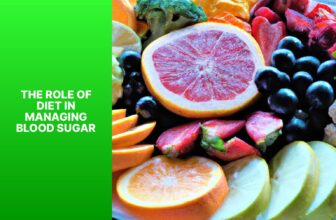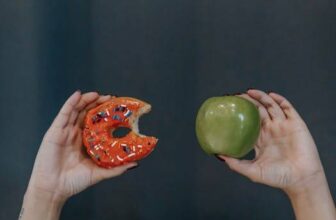Descubre las frutas recomendadas para diabéticos
Key Takeaway:
- Controlling diabetes with the right diet is crucial, and incorporating fruits can provide essential nutrients and fiber. Some fruits that are low in sugar and safe for diabetics include berries, citrus fruits, and avocados.
- Portion control and balance are important when including fruits in a diabetic diet. It is recommended to have 1-2 servings of fruit per day and to pair them with a source of protein or healthy fat to slow down the absorption of sugar.
- Fruits to avoid for diabetics include high sugar fruits like grapes, mangoes, and bananas, as they can raise blood glucose levels. It is important to be mindful of the glycemic index and limit intake of these fruits.
Introduction to the topic of which fruits are safe for diabetics to consume
Maintaining a healthy and balanced diet is crucial for individuals with diabetes to prevent spikes in blood sugar levels. With so many different types of fruit available, it can be difficult to know which ones are safe for diabetics to consume. In this section, we will discuss the importance of controlling diabetes through a proper diet, and explore which fruits are diabetic-friendly.
Importance of controlling diabetes with the right diet
Managing diabetes through a proper diet is key. The need for controlling diabetes with a balanced diet cannot be underestimated. Eating the right food can help keep blood sugar levels in check and stop problems connected with the illness. Diabetics have trouble managing glucose, which can lead to major health issues like blindness, kidney failure, and nerve damage. It is critical to manage diabetes by eating meals that contain the correct amount of carbs, proteins, vitamins, and minerals.
Fruit intake should be monitored carefully, as eating too many high-sugar fruits can cause elevated blood sugar. Berries and citrus fruits are good choices because they have low sugar. Looking at portion sizes and having the correct fruit-carb ratio in meals can also help with glucose levels. People might think that cutting out all sugar helps diabetes, but this is wrong. Sugars are present in most carbs like pasta, rice, and bread, so moderation is important.
Surprisingly, including fruit in a diabetic’s daily routine can have positive results. Whole fruits with lots of fiber produce slower glucose absorption rates than juice. Also, eating fruits with pulp limits the spike in glucose after eating. Plus, fiber-rich fruits reduce inflammation, lowering the risk of heart disease and obesity. So, it is clear that including fiber-rich fruits in a diet is essential to control diabetes.
List of recommended fruits for diabetics
Looking for the perfect fruits to add to your diabetic diet? This section has got you covered. We’ll be discussing a list of recommended fruits for diabetics, including fruits that are low in sugar and safe to eat, as well as tips on portion control and balance when including fruit in your diet. Say goodbye to confusion and hello to healthy, tasty fruit options!
Fruits that are low in sugar and safe for diabetics
Including fruit in the diet of those with diabetes can be tough, as certain fruits can cause a sudden rise in blood sugar. However, there are low-sugar fruits that are safe to consume.
Berries such as strawberries, raspberries, and blackberries are ideal, as they have low sugar and plenty of fiber. The fiber slows down sugar absorption, helping to maintain blood glucose. Citrus fruits like oranges, lemons and grapefruits have a low glycemic index, and also contain flavonoids which improve insulin sensitivity. Apples are also great for diabetics, with their high fiber content – just remember to leave the skin on! Avocados are unique; they are high in healthy fats and low in carbohydrates, making them a perfect addition to a diabetic diet.
It is important to monitor portion size and balance when including fruit in your diet; this prevents unexpected sugar spikes. Other fruits that can be consumed by diabetics but should be monitored carefully are bananas, grapes, and mangoes.
To ensure the best benefits from consuming fruit while managing diabetes, it’s recommended to have at least 2-3 servings per day. Choose whole fruits over juices or dried fruits, which may contain added sugar.
If you’re unsure what fruits are best for you, it’s best to speak to a healthcare provider or nutritionist who can make tailored recommendations. Don’t miss out on the delicious and nutritious benefits of including fruit in your diet, but remember to do so with caution and moderation to maintain healthy blood sugar levels. Finding the right balance is key!
Portion control and balance when including fruits in a diabetic diet
For diabetics, portion control and balance are key when it comes to fruit. Low-sugar fruits like berries, avocados, kiwifruit and citrus have a lower glycemic index and should be chosen. Keeping track of carbohydrate intake daily is helpful too.
Including skin or pulp of fruits is recommended for fiber and balanced glucose levels. High-sugar fruits like pineapples, mangoes, bananas, dates and raisins should either be limited or avoided.
Research shows diets rich in vegetables and fresh fruits can reduce the risk of type 2 diabetes. So, there are many healthy options. But, pineapple lovers with diabetes should stay away!
Fruits to avoid for diabetics
Did you know that certain fruits can have detrimental effects on blood glucose levels in diabetics? In this section, we’ll explore some high-sugar fruits that diabetics should avoid to keep their blood sugar in check.
From bananas to mangoes, we’ll take a closer look at which fruits can cause a spike in glucose levels, providing you with facts and insights to help you make informed choices about your diet.
High sugar fruits that can raise blood glucose levels
Fruits high in sugar can cause a spike in blood glucose levels – which is troublesome for diabetics. So it’s important to know which fruits are high in sugar! Mangos, cherries, pineapple and pomegranate are all high-sugar fruits. Citrus fruits like oranges and grapefruit also contain high amounts of sugar. Limit the serving sizes of these fruits.
Dried fruits like prunes, raisins and apricots should be avoided – they contain even more sugar than fresh fruits and don’t help you feel full. Balance your diet with low-glycemic fruits like berries, apples, grapes and peaches. These low-sugar options give you important nutrients and help you manage your glucose levels.
The National Institute of Diabetes and Digestive Kidney Systems (NIDDKS) suggests including fiber-rich foods in your diet to help manage diabetes. In conclusion, some fruits are better than others when it comes to managing diabetes – be aware of high-sugar fruits!
Myths about sugar and fruits for diabetics
Diabetes management can be tricky with misunderstandings and misconceptions about sugar and fruit. Many think sugar should be avoided, which can create confusion. While monitoring sugar intake is key, it’s not necessary to cut out all fruits. High sugar fruits should be eaten in moderation, but low-sugar fruits like berries, oranges, and apples can be consumed more. Dried fruits should also be eaten responsibly, while fruit juices should be avoided due to their high sugar content and lack of fiber. Eating fruits with a source of protein or fat can help stabilize blood sugar levels. Consult healthcare professionals for personalized recommendations on fruit intake.
Fruits aren’t the only contributors to high sugar intake for diabetics. Monitoring overall sugar intake and maintaining a balanced diet is vital. Recognizing myths and truths is fundamental to diabetes management. Educating and consulting healthcare professionals can help diabetics better understand and manage their condition.
Table of fruit carbohydrates amounts and serving sizes
Fruit and diabetes? Not a problem! For those managing diabetes, understanding carbs and serving sizes is vital. Here’s what you need to know:
A comprehensive table of fruit carbs, glycemic index, glycemic load, and fiber makes it easier to choose the best fruits. Fresh or frozen fruits are preferable as canned or dried ones often have added sugars. Pairing fruits with protein and fat can help slow down carb absorption.
By following these simple steps, individuals with diabetes can enjoy a range of fruits and keep their blood sugar levels healthy.
Importance of eating fruits with skin or pulp for fiber and balanced glucose levels
It’s critical for diabetic individuals to eat fruits with skin or pulp. These fruits are an ideal source of fiber. It decreases the absorption of sugar in the body, thus stopping sudden increases in blood sugar levels. This helps manage diabetes symptoms and reduces complications.
Fruits with skin or pulp should be included in a diabetic diet. They contain essential nutrients like vitamins, minerals, and antioxidants. Examples include apples, oranges, pears, berries, and kiwis. It is important to monitor portion sizes and carbohydrate intake to maintain balance and control blood sugar.
Rather than juices, whole fruits should be consumed. Juices may contain added sugars and have a greater glycemic load. Sometimes, the skin of the fruit can be bitter or hard to eat. Alternatives or advice from a registered dietician may be necessary to guarantee a diverse and nutritious diet. Eating fruits with skin or pulp can aid digestion and increase satiety, contributing to a healthy lifestyle for diabetic individuals.
Recommended daily fruit intake for diabetics
Diabetics should consume a moderate amount of fruit every day. This helps the body stay nourished and keeps blood sugar levels in check. Fruits with low glycemic index, like oranges, apples, strawberries, pears, kiwi, and grapefruit, are great. High fiber fruits such as bananas, avocados, and berries can be beneficial too. Limit dried fruit, juices, and canned fruits in syrup.
Fruit consumption is still possible – they are a natural source of vitamins and nutrients. A balanced diet with some fruit can help diabetics maintain their health.
Angel’s grandma was diagnosed with diabetes. She consulted a dietician who recommended moderate consumption of certain fruits to add nutrients while managing her blood sugar.
Conclusion and additional information available on the topic .
In the end, including fruits in a diabetic’s diet needs careful thought. Opt for fruits with low GI scores, like berries, oranges, apples and avocados. This can stop blood sugar levels from rising. The article ‘que frutas puede comer un diabetico’ has more data on suitable fruits and stresses eating fruits with skin and pulp for their high fiber content.
A balanced lifestyle, regular exercise, proper medication and controlled fruit consumption can help control blood sugar. Artificial sweeteners and sugar-free products should be used with caution. Read the article for more information.
Five Facts About “Que Frutas Puede Comer Un Diabetico”:
- ✅ Diabetics can enjoy a variety of fruits, but portion control and balance are key when including fruits in their diet. (Source: Clivi)
- ✅ To control diabetes, it is recommended to consume fruits such as blueberries, raspberries, currants, lemon, melon, blackberry, grapefruit, watermelon, apricot, plum, strawberry, pomegranate, kiwi, apple, tangerine, passion fruit, peach, orange, nectarine, papaya, peach, pear, and pineapple. (Source: Fundación del Corazón)
- ✅ Diabetics can eat all fruits, but it depends on their blood glucose levels and overall diet. (Source: Clivi)
- ✅ Fruits high in carbohydrates, such as dried fruits, canned fruits, or natural juices, can be consumed by diabetics but in moderation, as they provide a lot of sugar and little fiber, increasing glucose levels in the blood. (Source: Tuasaude)
- ✅ Fruit fiber reduces the speed at which the body absorbs sugar from the fruit in the intestine, helping to keep glucose levels balanced in the blood. (Source: Tuasaude)
FAQs about Que Frutas Puede Comer Un Diabetico
What fruits can a diabetic eat after having a heart attack?
After having a heart attack, it is recommended to consume fruits such as blueberries, raspberries, currants, lemon, melon, blackberry, grapefruit, watermelon, apricot, plum, strawberry, pomegranate, kiwi, apple, tangerine, passion fruit, peach, orange, nectarine, papaya, pear and pineapple. It is advised to avoid fruits with higher sugar content such as figs, cherries, persimmons, mangoes, bananas, grapes, canned pineapple, canned peaches, raisins, dates, and dried figs.
How many pieces of fruit are recommended for diabetics?
It is recommended for diabetics to consume 2-3 servings or pieces of fruit per day.
What is the amount of carbohydrates present in a medium-sized fruit?
One medium fresh fruit contains around 15 to 20 g of carbohydrates.
Are diabetics allowed to eat all fruits?
Yes, diabetics can eat all fruits, but it depends on their blood glucose levels and overall diet.
What portion size of fruits is recommended for diabetics?
It is important for diabetics to eat small portions of fruit throughout the day, and recommended portion sizes for different fruits are listed in the table provided by the sources.
Why are fruits with skin or pulp recommended for diabetics?
Fruits with skin or pulp like mandarins, apples, pears, kiwis, and oranges provide a good amount of fiber to the diet, which helps reduce the speed at which the body absorbs sugar from the fruit in the intestine, helping to keep glucose levels balanced in the blood.







